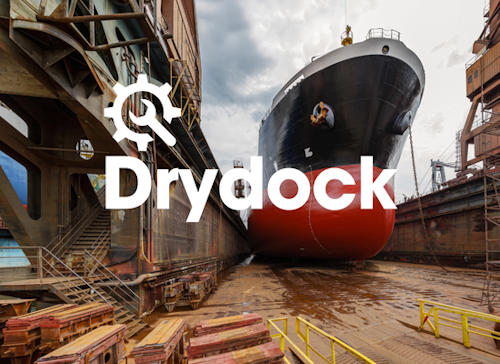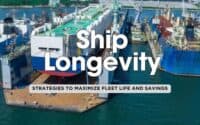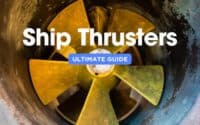101 Essential Items to Address at Drydock

A well-planned dry-docking period is fundamental to maintaining the ship's structural integrity, operational efficiency, and adherence to international regulations. This checklist serves as a vital tool for shipowners and operators to streamline the dry-docking process, making sure that crucial maintenance activities are efficiently carried out. The top items listed are the most critical for ensuring the ship's overall performance and safety, including essential tasks like hull cleaning, propulsion system maintenance, and safety equipment checks.
Prioritizing Critical Tasks
Addressing these primary items is crucial for several reasons:
- Optimal Performance: Regular hull cleaning and propeller maintenance reduce drag and improve fuel efficiency.
- Safety: Inspections of safety and emergency systems are vital for crew and vessel safety.
- Compliance: Many of these tasks are required to meet the stringent standards of maritime regulatory bodies and classification societies.
Additional Considerations
Beyond the top critical tasks, this checklist also includes additional items that, while not immediately pressing, are important for a thorough maintenance routine. These extra items ensure that no aspect of the vessel's operation is neglected, covering less obvious but still essential areas like accommodation systems, minor machinery components, and auxiliary systems. Addressing these areas can prevent minor issues from escalating into significant problems, contributing to the overall longevity and reliability of the ship.
| Category | Task | Description |
|---|---|---|
| Hull and Structure | Hull Cleaning | Removal of biofouling, algae, and barnacles. |
| Hull Inspection | Check for cracks, corrosion, and other structural issues. | |
| Hull Coating | Reapply anti-fouling paint and inspect coating condition. | |
| Ultrasonic Thickness Testing | Measure hull thickness for signs of thinning or damage. | |
| Ballast Tank Inspection | Examine and clean ballast tanks, check for corrosion. | |
| Cathodic Protection | Inspect and replace anodes to prevent corrosion. | |
| Hydro-blasting | Use high-pressure water blasting for removing old paint and rust. | |
| Internal Hull Inspections | Inspect internal hull compartments for structural integrity. | |
| Void Space Checks | Check and maintain void spaces for leaks and corrosion. | |
| Painting Above Waterline | Touch up or repaint areas above the waterline as needed. | |
| Spare Paint and Coating Inventory | Review and restock inventory for paints and coatings. | |
| Non-Destructive Testing | Perform non-destructive testing on critical structural components. | |
| Propulsion System | Propeller Cleaning | Remove fouling and inspect for damage. |
| Propeller Polishing | Polish blades to improve efficiency. | |
| Shaft Alignment | Check and realign the propeller shaft as needed. | |
| Shaft Seals | Inspect and replace seals to prevent leaks. | |
| Stern Tube Inspection | Examine and maintain the stern tube and bearings. | |
| Rudder Inspection | Check rudder and pintle bearings for wear or damage. | |
| Rudder Stock Inspection | Inspect the condition and alignment of the rudder stock. | |
| Propeller Shaft Bearings | Inspect and replace worn-out bearings. | |
| Gearbox Inspection | Check the gearbox for wear, lubrication, and proper alignment. | |
| Underwater Equipment | Bow Thruster Inspection | Inspect and maintain bow thruster units. |
| Sea Chest Cleaning | Clean sea chests and inspect for corrosion or blockages. | |
| Strainers and Gratings | Clean and inspect seawater strainers and gratings. | |
| Sacrificial Anodes | Check and replace as necessary. | |
| Underwater Cameras | Install or check underwater cameras for hull inspection. | |
| Underwater Lighting | Inspect and maintain underwater lighting systems. | |
| Safety and Compliance | Safety Equipment Inspection | Inspect lifeboats, life rafts, and other safety equipment. |
| Firefighting Systems Check | Check and service fire suppression systems. | |
| Pollution Control Systems | Inspect systems like oily water separators and sewage treatment units. | |
| Emergency Systems Testing | Test and service emergency power and lighting systems. | |
| Navigation Light Inspection | Check and maintain all navigation lights for compliance. | |
| Bridge Equipment | Inspect and service all bridge navigation and communication equipment. | |
| Lifejacket and Lifeboat Inspections | Verify the condition and availability of lifejackets and lifeboats. | |
| Emergency Towing Gear | Inspect and maintain emergency towing gear and arrangements. | |
| Class Inspections | Complete all required class inspections and certifications. | |
| Safety Drills | Conduct safety drills and check crew preparedness. | |
| Regulatory Documentation | Ensure all regulatory documentation is updated. | |
| Compliance Audits | Conduct audits for compliance with international maritime regulations. | |
| Machinery and Systems | Main Engine Inspection | Overhaul or maintain main engines as required. |
| Auxiliary Engines Service | Service and inspect auxiliary engines and generators. | |
| Pumps and Valves Check | Inspect and service bilge pumps, ballast pumps, and critical valves. | |
| Heat Exchangers | Clean and inspect heat exchangers and coolers. | |
| Piping Systems | Check for leaks, corrosion, and integrity of piping systems. | |
| Fuel Systems | Inspect fuel tanks, pipelines, and filters. | |
| Lubrication Systems | Check and service lubrication systems, including oil changes. | |
| Hydraulic Systems | Inspect and maintain hydraulic machinery and systems. | |
| Steering Gear | Inspect and test steering gear for proper operation. | |
| Engine Mounts | Inspect and replace worn engine mounts. | |
| Turbines | Check and maintain turbochargers and turbines for efficiency. | |
| Cooling Systems | Flush and inspect cooling systems for proper operation. | |
| Electrical and Control Systems | Electrical Wiring | Inspect and replace damaged or worn electrical wiring. |
| Switchboards and Panels | Test and maintain electrical switchboards and control panels. | |
| Navigation Systems | Service and calibrate navigation equipment. | |
| Communication Systems | Check and maintain communication devices and systems. | |
| Alarm Systems | Test and ensure all alarms are functional. | |
| Emergency Generators | Test and maintain emergency generators and power systems. | |
| UPS Systems | Inspect and test uninterruptible power supply systems. | |
| Battery Systems | Check and maintain all battery systems for backup power. | |
| Bridge Control Systems | Inspect and update bridge control systems and automation. | |
| Deck and Cargo Handling | Deck Equipment | Inspect winches, cranes, and other deck machinery. |
| Hatch Covers | Inspect and maintain hatch covers for watertight integrity. | |
| Cargo Hold Inspection | Clean and inspect cargo holds for damage or corrosion. | |
| Mooring Equipment | Check and service mooring lines, winches, and fairleads. | |
| Deck Crane Hydraulics | Check and maintain the hydraulic systems of deck cranes. | |
| Deck Plating | Inspect deck plating for corrosion and wear, and repair as necessary. | |
| Cargo Securing Gear | Inspect and maintain cargo securing gear and equipment. | |
| Pilot Ladders and Boarding Arrangements | Check and maintain pilot ladders and boarding arrangements for compliance. | |
| Anchoring Systems | Inspect and maintain anchors, chains, and windlasses. | |
| Accommodation and Habitability | HVAC Systems | Inspect and maintain heating, ventilation, and air conditioning systems. |
| Galley Equipment | Check and service kitchen and food preparation equipment. | |
| Sanitary Systems | Inspect and maintain plumbing and waste management systems. | |
| Lighting Systems | Ensure all accommodation lighting is operational and efficient. | |
| Accommodation Fire Safety | Check and maintain fire detection and suppression systems in accommodation areas. | |
| Laundry Equipment | Inspect and service laundry machines and related equipment. | |
| Entertainment Systems | Check and maintain onboard entertainment and communication systems for crew comfort. | |
| Freshwater Systems | Inspect and maintain freshwater generation and distribution systems. | |
| Ventilation Ducts | Clean and inspect ventilation ducts for blockages or damage. | |
| Inspection and Documentation | Class Inspections | Complete all required class inspections and certifications. |
| Safety Drills | Conduct safety drills and check crew preparedness. | |
| Regulatory Documentation | Ensure all regulatory documentation is updated. | |
| Insurance Surveys | Arrange for insurance surveys and ensure all documentation is current. | |
| Compliance Audits | Conduct audits for compliance with international maritime regulations. | |
| Environmental Compliance | Verify compliance with MARPOL and other environmental regulations. | |
| Logistics Coordination | Plan for logistics support such as tug services and supply deliveries. | |
| Crew Training | Provide any necessary training or updates for the crew on new equipment or procedures. | |
| Digital Inspections | Use ROVs and other technology for interim inspections to identify issues early and plan dry-docking efficiently. | |
| Miscellaneous | Waste Management Systems | Check and maintain systems for handling and processing waste. |
| Spare Parts Inventory | Review and restock spare parts inventory. | |
| Ship Stability | Verify ship stability calculations and adjust ballast as necessary. | |
| Fuel Tank Cleaning | Clean and inspect fuel tanks for sludge and contamination. | |
| Air Compressor Maintenance | Check and maintain air compressors for proper operation. | |
| Mooring Line Inspections | Inspect and replace mooring lines as necessary. | |
| Vent Pipe Inspections | Check vent pipes for blockages and corrosion. | |
| Anchoring Systems | Inspect and maintain anchors, chains, and windlasses; check for wear, deformation, and corrosion; ensure proper function of windlass brakes and controls; inspect chain stoppers and securing arrangements. | |

Do you have a Maritime Product or Service that may be of interest to Shipowners? Tell us about it here!
Do you have feedback or insights? Please reach out to editor @ shipuniverse.com



